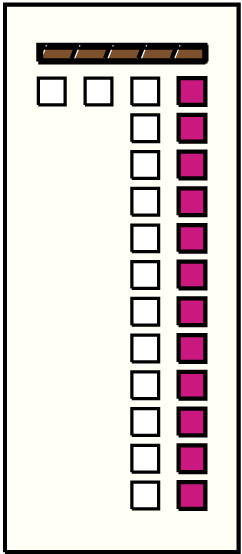UR1163/KH0180 - Ascher Decreasing Groups
Drawings:
Ascher Decreasing Group:
Click on Image to View Larger
Individual Ascher Decreasing Groups: - Click on column name to sort
| # | Decreasing Group Schema | Group Position 1 Based Index |
# Cords in Group | Decreasing Cord Values |
|---|---|---|---|---|
| 0 |  | 3 | 12 | B@[3, 1]:18 + BB@[3, 2]:21 + B@[3, 3]:18 + BB@[3, 4]:12 + B@[3, 5]:9 + BB@[3, 6]:9 + B@[3, 7]:5 + BB@[3, 8]:4 + BB@[3, 9]:3 + BB@[3, 10]:2 + B@[3, 11]:2 + BB@[3, 12]:2 |
| 1 |  | 4 | 12 | B@[4, 1]:13 + B@[4, 2]:15 + B@[4, 3]:7 + B@[4, 4]:7 + B@[4, 5]:0 + B@[4, 6]:2 + B@[4, 7]:4 + B@[4, 8]:4 + B@[4, 9]:0 + B@[4, 10]:0 + B@[4, 11]:2 + B@[4, 12]:0 |
Khipu Notes:
Ascher Databook Notes:
- Construction note: The twisted end of cord 1 is linked through the twisted end of the main cord so that it dangles from the end of the main cord. (See diagram for UR1100.)
- This is one of several khipus acquired by the Museum in 1907 with provenance Pachacamac. For others included in this group, see UR1097.
- By spacing there are 2 single pendants and then 2 groups of 12 pendants each.
- The value of pendant 1 is the sum of the values in Group 1.
- With one exception, the colors of the pendants in Group 1 alternate (B, BB, B, BB, etc.) while in Group 2, all pendants are B.
The sums of the B colored pendants in Group 1, the BB pendants in Group 1, and the B pendants in Group 2 are 52, 53, 54 respectively. - The following regularities are found in Group 1:
- Pi = Pi+1 i=(5,10,11)
Pi = Pi+2 i=(1,10)
- Pi = Pi+2 + Pi+3 i=(2,3,5,7,8) but not i=(1,4,6 9)
- Pi * P13-i = 36 i=(1,3,4,5) but not i=(2,6)
Of these, the following also hold:\[ \frac{P_{i}}{P_{i+1}}=\frac{P_{12-i}}{P_{13-i}}\;\;\;for\;i=(3,4) \]
- Pi = Pi+1 i=(5,10,11)
- The following regularities are found in Group 2:
- Pi = Pi+1 i=(3,7,9)
Pi = Pi+2 i=(10)
- Pi = Pi+2 + Pi-1 i=(3,7)
- Pi * P13-i = 0 i=(1,3,4,5) but not i=(2,6)
- \[ P_{1} = \sum\limits_{i=2}^{6}P_{2i-1}=\sum\limits_{i=2}^{6}P_{2i} \]
- Pi = Pi+1 i=(3,7,9)
- Comparing the regularities within each group, the following similarities are found between the groups:
- There are 3 consecutive equal pairs and P10= P12
- Pi = Pi+2 + Pi+c i=(3,7) for Group 1, c=3 while for Group 2, c=1
- Pi * P13-i = K i=(1,3,4,5) for Group 1, K=36 while for Group 2, K=0.
- In every position, the values in Group 1 are greater than or equal to the values in Group 2. For both groups:
P1 > P2 > P3 ≥ P4 > P5
P7 ≥ P8 > P9 ≥ P10
